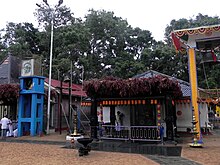Kataragama temple
| Kataragama temple | |
|---|---|
 Maha Devale/Murukan Kovil | |
| Religion | |
| Affiliation | Hinduism |
| Province | Uva |
| Location | |
| Location | Kataragama |
| Country | Sri Lanka |
| Geographic coordinates | 6°25′N 81°20′E / 6.417°N 81.333°E |
The Kataragamam temple (Sinhala: රුහුණු කතරගම දේවාලය, lit. 'Ruhuṇu Kataragama Dēvālaya', Tamil: கதிர்காமம் முருகன் கோயில், lit. 'Katirkāmam Murukaṉ Kōyil') complex dedicated to Skanda-Kumara is one of the few religious sites in Sri Lanka that is venerated by the majority Sinhala Buddhists, Hindu minority Sri Lankan Tamil people, Sri Lankan Moors and the Vedda people. It is a collection of modest shrines, of which the one dedicated to Skanda-Kumara, is the most important.
It has been considered hallowed ground since almost three hundred years before the birth of Christ, and is one of the sixteen places said to have been consecrated by Gautama Buddha as he meditated. It was built approximately between 1100 - 15th century [1]
Legend has it that this happened during the Buddha's third visit to Sri Lanka, during the reign of the provincial King Mahasena in the sixth century BC. Kataragama is sacred to Lord Murugan, also familiarly known as Kartikeya. Lord Muruga has many shrines and places of worship. Among them are Alaivai, now known as Tiruchendur, a shrine on the southern coast of India about 36 miles from Tinnevelly; Avinankudi, now called as Palani Malai (Palani Hills), about the same distance from Dindigul; and Tiru-Erakam, now known as Swamimalai, a hill about four miles from Kumbakonam. Three of the shrines are situated amid mountains and forests, the deity is known as the God of the mountaneous regions.
Muruga is worshipped as a deity whom embodies the pure Hindu ideal of God being in all things and manifesting himself wherever he is called to with love.There are many stories about Murugan, or Skanda-Kumara as He is more commonly known there. Skanda-Kumara's place of worship is held dear by many Sri Lankans who consider the Kataragama complex and its temples holy and make annual pilgrimages there.
But perhaps the most unique feature of Kataragama, and what makes it really stand out is its relative unassumingness. Almost all its shrines are unremarkable minor buildings free of any embellishment. There is absolutely no representation of deities decorating the exterior of the buildings.
This is in marked contrast to any other Hindu temple in Sri Lanka or India, that are usually covered with carvings and statues of gods and goddesses in colourful scene. Practically all the shrines are made out of stone with the exception of one dedicated to the Goddess Valli which has been constructed with timber.
Almost 2500 years later, Kataragama still holds a special place in the heart of devotees of Lord Muruga
References
[change | change source]- ↑ Peiris, Kamalika (31 July 2009). "Ancient and medieval Hindu temples in Sri Lanka". Archived from the original on 29 June 2011. Retrieved 6 October 2010.
